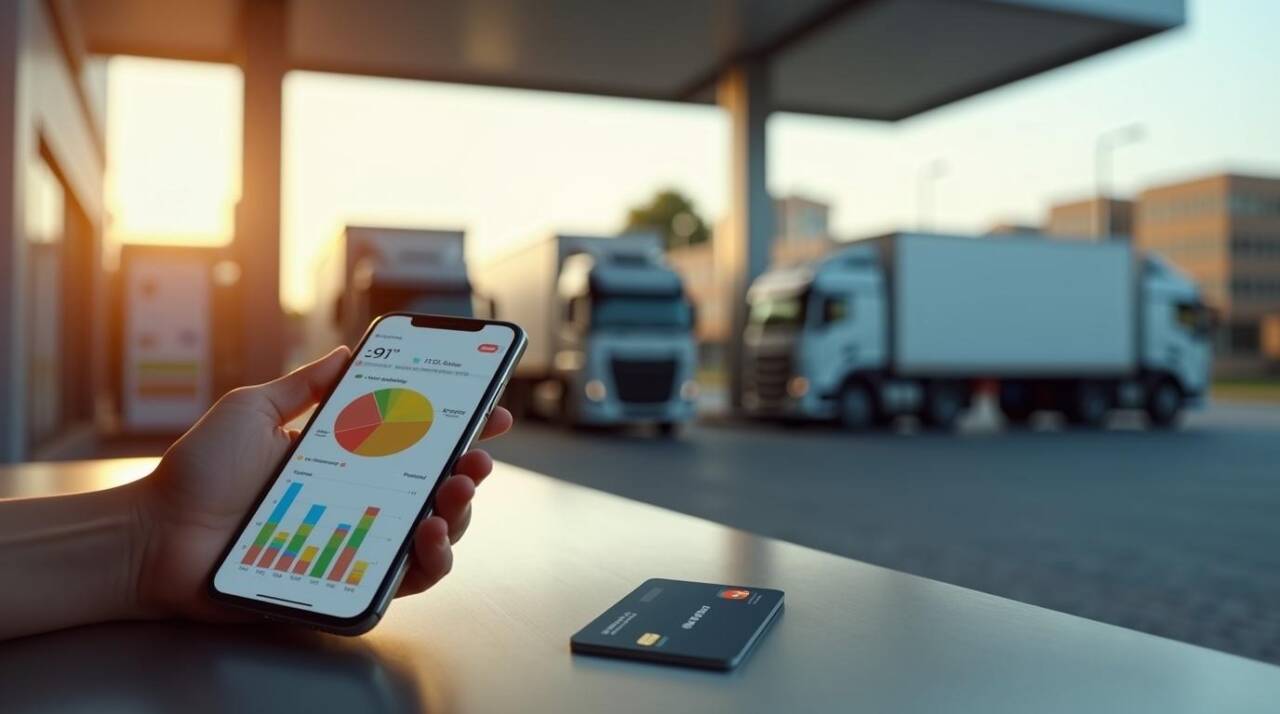If you’re tired of managing receipts and unpredictable fuel expenses across multiple vehicles, you’re not alone. Fleet fuel cards provide businesses with automated expense tracking, real-time purchase controls, and significant savings through network discounts. Whether you manage five vehicles or five hundred, these specialized payment solutions transform how companies handle their Speedway 7/11 fleet fuel cards and other fuel purchases while providing unprecedented visibility into driver spending patterns.
What Are Fleet Fuel Cards and How Do They Work
A fleet card functions as a specialized payment method designed exclusively for vehicle-related purchases. Unlike traditional credit cards, these solutions offer granular control over what drivers can buy, where they can make purchases, and how much they can spend. Each driver receives their own card linked to a central account, allowing fleet managers to monitor transactions in real-time through online dashboards and mobile apps.
The system works by connecting your business account to a network of participating gas stations and service locations. When drivers make purchases, the transaction data flows directly into your management platform, capturing details like gallons purchased, price per gallon, location, time, and vehicle identification. This automated tracking eliminates manual expense reports while providing instant visibility into fuel costs across your entire fleet.
Top Benefits of Using Fleet Fuel Cards for Your Business
Cost Control Through Purchase Limits and Restrictions
Purchase controls represent one of the most powerful features for businesses looking to manage expenses. Fleet managers can set specific parameters for each card, including daily or weekly spending limits, restrictions on non-fuel purchases, and geographic boundaries for transactions. These controls prevent unauthorized spending while ensuring drivers have the resources they need to complete their routes efficiently.
Advanced restriction options include limiting purchases to specific fuel types, blocking convenience store items, and setting maximum gallon limits per transaction. Some platforms even allow time-based restrictions, preventing card usage outside of business hours or scheduled shifts. This level of control significantly reduces the risk of fraud and misuse while maintaining operational flexibility.
Real-Time Expense Tracking and Reporting
Traditional expense management requires collecting receipts, entering data manually, and reconciling statements weeks after purchases occur. Fuel card programs eliminate these inefficiencies by automatically capturing and categorizing every transaction. Fleet managers access comprehensive reports showing spending patterns, driver behavior, and vehicle efficiency metrics through intuitive online dashboards.
The reporting capabilities extend beyond basic transaction logs. Advanced analytics tools identify trends in fuel consumption, highlight unusual spending patterns, and compare efficiency across different vehicles or drivers. This data enables informed decisions about route optimization, vehicle maintenance schedules, and driver training opportunities. Integration with accounting software further streamlines operations by automatically syncing expense data with your financial systems.
Fuel Savings Through Network Discounts and Rebates
Participating in a fuel card program unlocks immediate savings through negotiated network discounts. Most providers offer reduced prices at thousands of locations nationwide, with discounts ranging from 3 to 10 cents per gallon depending on volume and location. These savings accumulate quickly, especially for businesses with multiple vehicles making frequent purchases.
Volume-based rebate programs provide additional savings opportunities for larger fleets. As your monthly fuel purchases increase, you qualify for higher rebate tiers that can return significant amounts to your bottom line. Some programs also offer promotional periods with enhanced discounts at specific station brands or geographic regions, allowing strategic planning to maximize savings.
Leading Fleet Fuel Card Providers and Their Features
WEX Fleet Cards – Market Leader with Extensive Network
WEX Inc stands as the largest provider in the industry, offering access to over 95% of U.S. gas stations through their extensive network. The WEX fleet card platform combines robust purchase controls with sophisticated analytics tools, making it suitable for businesses of all sizes. Their mobile app enables drivers to locate nearby stations, check current prices, and submit maintenance receipts digitally.
The company offers multiple card options tailored to different business needs. Small fleets benefit from simplified pricing structures with no setup fees, while enterprise customers access advanced features like custom reporting, API integration, and dedicated account management. WEX also leads in electric vehicle support, providing charging station access alongside traditional fuel purchases.
Fuelman Cards – Comprehensive Fleet Management Integration
Fuelman differentiates itself through deep integration capabilities with existing fleet management systems. Their platform seamlessly connects with telematics devices, maintenance scheduling software, and GPS tracking solutions to provide a unified view of fleet operations. This integration enables automatic mileage tracking, predictive maintenance alerts, and route optimization based on fuel prices.
The Fuelman network includes over 50,000 locations nationwide, with particularly strong coverage at independent stations and regional chains. Their tiered pricing model rewards higher volume customers with better discounts and lower transaction fees. The platform also excels in security features, offering biometric driver verification and AI-powered fraud detection that identifies suspicious patterns before losses occur.
BP Fleet Cards – Brand-Specific Savings and Rewards
BP’s fleet solution combines the benefits of a major oil company’s infrastructure with modern card management technology. Customers receive premium discounts at BP and Amoco stations while maintaining access to a broader network for convenience. The program includes unique rewards for loyalty, with points earned on purchases convertible to future fuel discounts or maintenance services.
The BP platform emphasizes simplicity for small to medium businesses. Their streamlined application process gets cards in drivers’ hands quickly, while the intuitive management portal requires minimal training. Monthly statements clearly show savings achieved through the program, making it easy to demonstrate ROI to stakeholders.
How to Choose the Right Fleet Fuel Card for Your Business
Evaluating Your Fleet Size and Fuel Usage Patterns
Understanding your specific needs forms the foundation for selecting an appropriate solution. Start by analyzing your current fuel expenses, including monthly volumes, average transaction sizes, and geographic distribution of purchases. Consider whether your vehicles operate locally, regionally, or nationwide, as this impacts which network provides the best coverage for your operations.
Different providers optimize their offerings for various fleet sizes. Companies with fewer than 10 vehicles often benefit from programs with no minimum purchase requirements and simple flat-rate discounts. Larger operations should prioritize platforms offering volume-based rebates, customizable reporting, and dedicated support teams. Also consider your growth projections, selecting a solution that can scale with your business without requiring a provider change.
Comparing Network Coverage and Station Locations
Network accessibility directly impacts both driver convenience and potential savings. Evaluate provider networks against your typical routes and operational areas. Urban fleets might prioritize density of locations, while long-haul operations need coverage along major highways. Consider not just the total number of stations, but their specific locations relative to your business needs.
Beyond basic coverage, examine the quality and types of stations included. Some networks focus on major brands with consistent amenities, while others include independent stations that might offer better prices. Check whether the network includes truck stops if you operate larger vehicles, and verify availability of diesel and alternative fuels if needed. Mobile apps that help drivers locate participating stations become essential tools for maximizing network benefits.
Understanding Fee Structures and Hidden Costs
Transparent pricing evaluation prevents unexpected costs from eroding anticipated savings. Common fees include per-card charges, monthly account maintenance, transaction processing, and setup costs. Some providers waive certain fees based on volume commitments, while others offer simple flat-rate structures. Request detailed fee schedules and calculate total costs based on your expected usage patterns.
Watch for less obvious charges that can impact your bottom line. These might include fees for replacement cards, paper statements, customer service calls, or accessing certain reports. Some programs require minimum monthly purchases to maintain discounted rates or charge penalties for account inactivity. Understanding the complete fee structure ensures accurate ROI calculations and prevents budget surprises.
Fleet Fuel Card Security and Fraud Prevention
PIN Protection and Driver Identification Systems
Security begins with robust driver authentication methods. Modern fuel card systems require unique PIN codes for each driver, creating an audit trail linking every transaction to a specific individual. Advanced platforms support multiple authentication factors, including driver license validation, vehicle odometer readings, and even biometric verification for high-security applications.
Driver ID systems go beyond simple PINs to create comprehensive profiles for each authorized user. These profiles can include photograph identification, driving record verification, and customized spending permissions based on job role or seniority. When drivers leave the company or change roles, administrators can instantly deactivate or modify access rights through the management portal, maintaining security without disrupting operations.
Purchase Controls and Transaction Monitoring
Granular purchase controls form the first line of defense against unauthorized spending. Administrators can restrict cards to fuel-only purchases, set maximum transaction amounts, limit daily purchase frequency, and define approved merchant categories. Geographic restrictions prevent card usage outside designated territories, while time-based controls block transactions during non-working hours.
Real-time monitoring systems continuously analyze transaction patterns to identify potential fraud or policy violations. Unusual activities like purchases in unexpected locations, transactions exceeding typical amounts, or rapid successive purchases trigger immediate alerts. These notifications allow fleet managers to investigate suspicious activity quickly, potentially blocking cards before significant losses occur.
Real-Time Alerts and Suspicious Activity Detection
Automated alert systems provide immediate notification when transactions violate established parameters or exhibit suspicious patterns. Managers can configure alerts for various scenarios, including purchases exceeding limits, transactions outside approved hours, or unusual purchase patterns. These notifications arrive via email, SMS, or push notifications through mobile apps, enabling rapid response to potential issues.
Machine learning algorithms enhance fraud detection by identifying subtle patterns humans might miss. These systems analyze historical data to establish baseline behavior for each driver and vehicle, then flag deviations that could indicate compromised cards or policy violations. As the system learns your fleet’s normal patterns, detection accuracy improves while false positives decrease.
Implementation and Getting Started
Application Process and Card Distribution
The application process typically begins with an online form collecting basic business information, including company structure, fleet size, and estimated monthly fuel spend. Most providers perform credit checks for payment terms, though some offer prepaid options that bypass credit requirements. Approval times range from instant for simple applications to several days for complex corporate accounts requiring customization.
Once approved, providers ship cards directly to your business or individual drivers within 7-10 business days. Each card arrives inactive for security, requiring phone or online activation before use. During this setup phase, administrators configure account settings, establish spending controls, and create driver profiles. Many providers offer implementation support, including dedicated onboarding specialists who guide you through initial configuration.
Setting Up Driver Controls and Spending Limits
Configuring appropriate controls requires balancing security with operational flexibility. Start by establishing baseline limits that prevent catastrophic fraud while allowing normal operations. Common starting points include daily spending caps of $200-300 per driver, fuel-only restrictions, and geographic boundaries matching your service territory. These parameters can be adjusted as you gain experience with the system.
Consider creating different control profiles for various driver categories. Long-haul drivers might need higher limits and broader geographic permissions than local delivery personnel. Maintenance managers might require access to service purchases beyond fuel. The management platform should support bulk updates for efficiency while allowing individual customization when needed.
Training Your Team on Proper Card Usage
Successful implementation depends on thorough driver education about card features, policies, and procedures. Develop clear guidelines covering authorized purchases, receipt requirements, PIN security, and lost card procedures. Explain how purchase controls work and why they exist, helping drivers understand that restrictions protect both the company and legitimate users from fraud.
Provide hands-on training with the mobile app or web portal drivers will use to find stations, check balances, or submit receipts. Create quick reference guides for common tasks and troubleshooting steps. Establish clear communication channels for drivers to report issues or ask questions, whether through a dedicated hotline, email address, or designated fleet manager. Regular refresher training ensures compliance as staff changes occur.
Maximizing Savings and ROI from Your Fleet Fuel Card Program
Leveraging Volume Discounts and Rebate Programs
Strategic consolidation of fuel purchases maximizes volume-based savings opportunities. Rather than allowing drivers to fuel at random locations, identify stations offering the best combination of base prices and card discounts. Communicate preferred locations to drivers through mobile apps or regular updates, potentially saving several cents per gallon through informed choices.
Understanding rebate tier structures helps optimize purchasing strategies. If you’re close to a higher rebate tier, concentrating purchases near month-end might push you over the threshold, applying better rates retroactively to the entire month’s volume. Some programs offer accelerated rebates for new customers or bonus periods with enhanced rates. Track these opportunities and adjust purchasing patterns to capitalize on temporary promotions.
Using Data Analytics for Route and Fuel Optimization
Transaction data reveals optimization opportunities beyond simple discount capture. Analyze fuel efficiency metrics across different vehicles to identify units requiring maintenance or replacement. Compare driver performance to recognize those achieving superior fuel economy, then share their techniques through training programs. Geographic purchase patterns might reveal inefficient routing that increases fuel consumption unnecessarily.
Advanced analytics platforms can integrate fuel card data with GPS tracking and delivery management systems. This combination enables sophisticated optimization algorithms that consider fuel prices, vehicle efficiency, traffic patterns, and delivery schedules simultaneously. The resulting route recommendations can reduce total fuel costs by 10-20% through smarter planning rather than just cheaper purchases.
Integrating with Fleet Management Software
API connections between fuel card platforms and fleet management software create powerful operational synergies. Automatic data synchronization eliminates manual entry while ensuring all systems reflect current information. Maintenance scheduling systems can trigger alerts based on fuel consumption patterns, while accounting software automatically categorizes expenses for tax reporting.
Integration enables sophisticated cost allocation across departments, projects, or customers. When fuel purchases automatically link to specific vehicles and jobs, you gain precise visibility into true operational costs. This granular data supports better pricing decisions, identifies unprofitable routes or customers, and validates the ROI of efficiency investments. The combination of payment control and operational insight transforms fuel management from a necessary expense into a strategic advantage.
Selecting and implementing the right fuel card solution requires careful evaluation of your specific needs, thorough comparison of available options, and strategic optimization of the chosen platform. By leveraging purchase controls, network discounts, and data analytics effectively, businesses transform fuel expenses from an unpredictable cost center into a managed, optimized component of their operations. The visibility and control provided by modern fuel card platforms enable continuous improvement in fleet efficiency while protecting against fraud and misuse.






